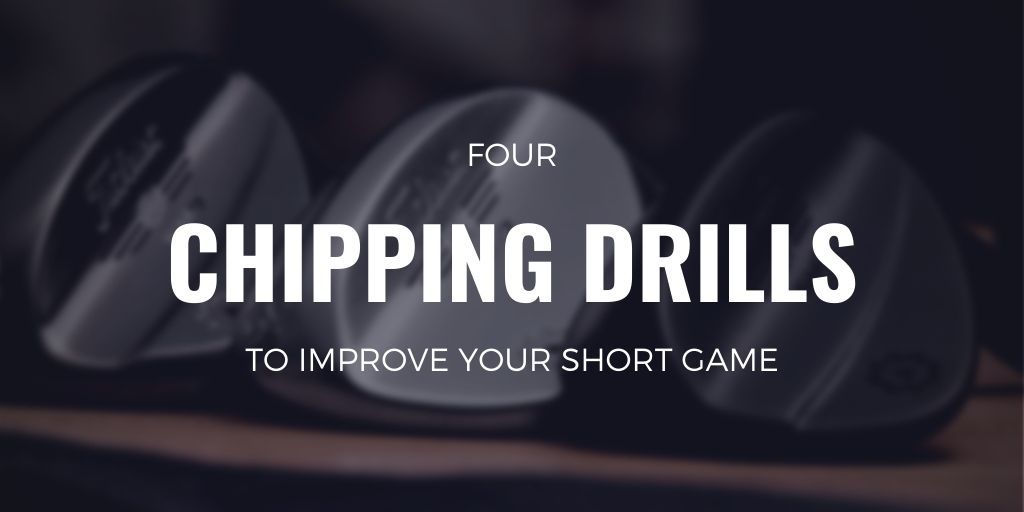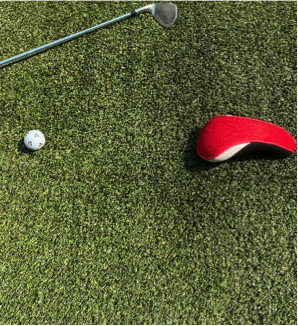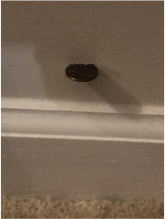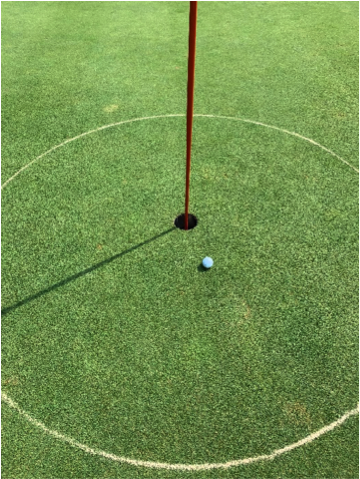
If you're struggling with the short game (and that's most of us!), don't give up. The best thing about this part of golf is that there are ways to practice it anywhere at any time, which can translate directly to shots saved on the course. To help with this, here are four chipping drills recommended by top instructors that anyone can use. Also, to add a bit of fun and competition to the practice, I've added three games to play with your chipping practice to really speed up the improvement.
Chipping Drill 1: Maintain the "y" with an Alignment Stick
This drill comes from British PGA Professional Jon Hearn, who has worked with Justin Rose and others on their short game. You will use an alignment stick to maintain an arm and club position to prevent you from flipping your wrists through impact.

To get started, take your standard grip on the club together with the alignment rod. A significant portion of the stick should extend past the grip (running parallel to the shaft).
Next, take a chipping stance, with your hands a bit in front of the ball, forming that lower-case y with your arms and the club. The alignment stick should be lightly touching the inside of your ribcage.
Start with a few hip-height swings. If you're breaking down and flipping your wrists, the alignment stick will let you know by smacking into your side at impact. An optimal impact position with hands slightly in front of the ball will keep that from happening.
Get comfortable with the motion and hit balls with the alignment stick for 10-15 minutes. Then take away the alignment rod and hit some more shots with just your regular club. This sort of practice with direct feedback can quickly engrain the feeling of solid chipping impact and improve your consistency. It is also an easy drill to come back to whenever you feel like you're losing that touch.
Want to experiment with this drill? Try hitting the chips from different ball positions, in line with your front armpit for a shot with more spin, your sternum for a bounce-and-check, and back armpit for a lower shot with more release.
Chipping Drill 2: Drop the Hand to Get Over the Yips
While the alignment stick drill above is excellent for out on the practice green, we can't or wouldn't do it out on the course mid-round. For that, here's a drill from renowned instructor Butch Harmon that can be done on the spot if you've found yourself with a case of the dreaded yips.
Usually, "yips" with chipping are caused by the lead arm stopping on the follow-through while the trailing arm keeps moving, breaking the lower-case y position discussed before and flipping the club through impact. To get over this, take a few practice swings before your chip, but as you start your downswing, allow your trailing hand to come off the club (right hand for right-handed golfers and vice versa) and keep your left arm moving through. Without your right hand on the club, you physically can't flip the clubhead with it, allowing for a simple swing thought to keep the left arm moving.
To combat the fear of the yips returning, Harmon recommends two practice swings with the drill, then immediately stepping in for your standard shot.
Chipping Drill 3: Stop the Chunks with a Headcover
A second drill from Butch Harmon is designed to help the average golfer with another type of disastrous chip shot - the chunk. A chunk is caused by the clubhead hitting behind the ball, digging into the ground, and making weak contact, if at all. The most common cause of this is that many amateur golfers, whether they are conscious of it or not, think they need to help the shot into the air, so they chip off their back foot, smacking the club into the ground. Unfortunately, this removes using the bounce of the wedge, which is its "safety net." In reality, the loft of the club will provide the height on the shot; no help is needed there, so the key is proper contact on the clubface.

To practice this contact, Harmon has a simple drill done with just a headcover. Place the empty headcover about a foot behind the ball and then practice your chipping. If you hit the headcover at all, then you're likely going to strike the turf before the ball. If you play the ball a bit back, lean left, and don't touch the headcover, then most likely, you're going to be striking the ball flush.
Chipping Drill 4: Home Practice without a Ball
One more key to consistent chipping is controlling the low-point of the swing. Too high and you've skulled it across the green; too low, and you're hitting the chunk described above. This drill will help you home in that low point with the added benefit that it can quickly be done at home. Instead of using a regular ball or foam practice ball, this practice is best done with flat objects such as the FlatBall training aid.
Coins are also very commonly used for this drill; however, use them with caution. Not only could the coins scratch up the face of a shiny new wedge (if you're concerned about that sort of thing), but a solid strike on a penny can produce some impressive results, as forum member C-Dubb discovered.

An alternative recommended by Adam Young is to utilize guitar picks. Not only are these thin and colorful, but they are also light enough to not cause any damage. In its simplest form, just spread the coins/picks on the carpet around a cup to act as your target and start chipping. Any sort of contact that gets the object airborne and reasonably towards the target means the clubhead had a solid low-point, as a "skulled" swing would miss the object completely.
Chipping Practice Game 1: Par 18
Just doing drills for chipping could get old quick, so to add an element of fun and competition (with only your own scores or with others), try this game popular among tour pros.
Around the practice area, select 9 different chipping locations and pins/targets on the green. If playing with a partner or group, alternate who chooses the location. This chipping location becomes the "hole," each with a par of 2. The object of the game is simple, complete the hole (chipping up and putting out) in as few strokes as possible, direct practice for getting up-and-down out on the course.
Utilize various shot locations and even specify the lie (sitting up, sitting down) to push yourself and other players to try different types of shots. Even on your own, record the total score as that will be your benchmark to beat the next time you play.

Chipping Practice Game 2: Darts
We all want to chip it close, so this game rewards you for getting the ball to finish as close to the target as possible. Starting from a target spot on the practice green, take a roughly three-foot stride out and place a tee, then another, and one or two more. Four tees would form three-foot, six-foot, nine-foot, and twelve-foot rings for scoring.

The scoring is simple: 1 point inside of the outer ring, 2 points, 3 points, and 4 points as you finish within the inner rings. Holing out or finishing on the target is worth 5 points.
You can adjust the scoring zone sizes or points as needed and to play, just have each player take a set number of shots and total the score. For the most accurate practice experience, just take one shot at a time, scoring each and clearing the ball. For an added wrinkle when playing with others or in teams, however, you can play alternating shots, leaving the balls where they finish, and not totaling the score until all shots are taken, giving the opportunity to knock balls out of the scoring rings like a game of curling.
Chipping Practice Game 3: One Shot, Three Clubs
The best chippers out there hit shots with various clubs and ball positions to get the type of shot they want, so this game will have your clubs "compete" against each other to be the champion chipper.
Like Par 18, this game will use nine different shot locations around the practice green. Grab a high-loft option (lob/sand wedge), a mid-loft option (PW/9 iron), and a low-loft option (8/7 iron or even something like a hybrid for low bump and runs). Hit one ball each from the same shot location, and whichever club finishes closest to the target wins the hole. Try different lengths and situations (clearing an obstacle, short-sided, etc.), and this game will help you master a variety of shot types you can then take out on the course instead of relying on just one club every time. Prizes for the club that wins are optional.
Bonus Section: Padraig Harrington's Guide to Chipping
Padraig Harrington recently launched a YouTube Channel, and this video is a must-watch for those looking to improve their chipping:
Do you have chipping drills of your own that can help other golfers? Please add them to the comments section, or in our community!
Also, you can check out my putting drills guide or swing path drill guide.
We care about the protection of your data Read our Privacy Policy